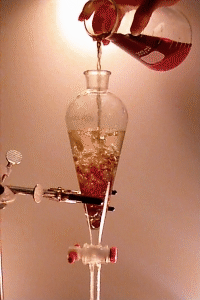
CHM3120L
Introduction to Analytical Chemistry: Laboratory
| Lab Schedule |
| LON-CAPA Pre-Labs |
| Resources |
| Contact Instructor |
| Chemistry Home Page |
![]()
Copper in Metal Alloys by Liquid-Liquid Extraction: Procedure
This experiment consists of three major steps:
- Preparation of sample and standards
- Extraction of the Cu-neocuproine complex into chloroform
- Determination of the absorbance of the chloroform/Cu-neocuproine solution.
The extraction step usually takes a full lab period, as six solutions (a blank, four standards and the sample) must be extracted in the same day so that color development for all solutions is allowed to proceed for approximately the same length of time.
Sample and Standard Preparation.
- Weigh exactly approximately 35 mg of a dried brass sample into a 250 mL Erlenmeyer flask.
- Add about 20 mL of H2O and 10 mL of concentrated HNO3.
- Digest this sample until it dissolves but be careful not to let the sample go to dryness.
- Quantitatively transfer the dissolved sample to a 100 mL volumetric flask and dilute to the mark.
- The sample is still too concentrated, so a 1:20 dilution is accomplished by transferring 5 mL of this solution to another 100 mL volumetric flask and diluting to the mark. This will be the solution from which copper will be extracted and quantitated.
- Weigh exactly approximately 39 mg of CuSO4·5H2O (not dried, formula weight 249.68) into a 100 mL volumetric flask. Dissolve in water and dilute to 100 mL. This should make a standard solution containing approximately 100 mg Cu/L.
- Prepare by dilution 100 mL each of copper standard solutions with concentrations approximately 5, 10, 15, and 25 mg/L.
Extraction.
The extraction procedure is the same for the sample, standards and blank (water).
- With a volumetric pipet, transfer 10 mL aliquots of the solution to a separatory funnel.
- Add 5 mL of 10% hydroxylamine hydrochloride solution and 10 mL of 30% sodium citrate solution.
- Add NH4OH until the pH is about 4.
- Add 10 mL of 0.1% neocuproine and 10 mL of chloroform, and then shake for 30 seconds. Be sure to vent the stopcock occasionally to release pressure in the funnel. Make sure you hold the cap in place while you are shaking the separatory funnel and that the cap is pointed away from other students (and the laboratory instructor!).
- Allow the layers to separate and draw off the lower CHCl3 phase into a 25 mL volumetric flask.
- Repeat the extraction with another fresh 5 mL portion of CHCl3, add this portion to the same flask that contains the original CHCl3 phase, and then dilute to the mark with CHCl3.
- Rinse the separatory funnel well between sample extractions with water. The chloroform extracts at this point will normally be cloudy because they are supersaturated with water. By the next lab period the excess water should separate into a distinct phase from the bulk of the chloroform.
Absorbance Measurements.
- The separated water layer can be removed from the bulk chloroform phase with a Pasteur pipet.
- Dilute back to the mark with chloroform.
- Measure the absorbance at 457 nm for the CHCl3/Cu(I)-neocuproine solution. Refer to the SPECTROPHOTOMETRIC DETERMINATION OF IRON experiment for instructions on the use of a spectrophotometer.
- Prepare a calibration curve (absorbance vs. Cu concentration, mg/L) using the Cu standards, and determine the percentage of Cu in the alloy. Don't forget to account for dilutions!